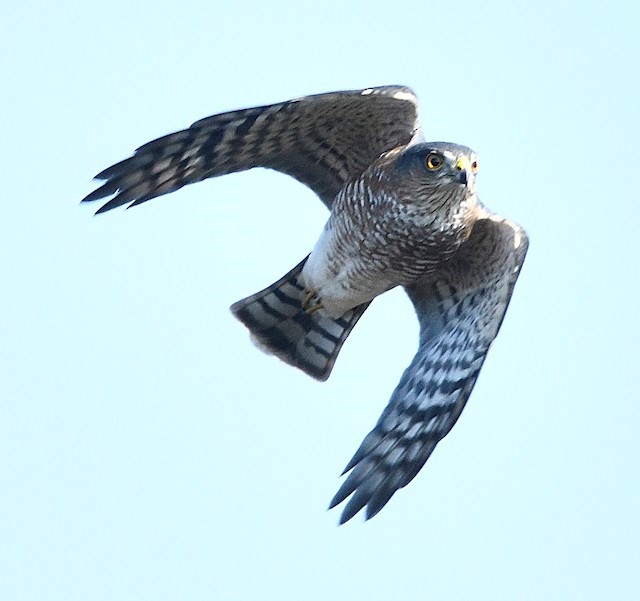Birdfinding.info ⇒ Fairly common across most of North America. When breeding, it retreats inconspicuously into forests. Nonbreeding birds can be found in nearly any wooded or semiopen habitat, including urban areas. Becomes especially common during fall migration along the Eastern Seaboard. In September and October, it can be seen in numbers at many favored hawk-watching spots, such as Hawk Mountain, Pennsylvania, and Cape May, New Jersey.
Sharp-shinned Hawk
Accipiter striatus
Breeds in North America from treeline to central Mexico. Winters from southern Alaska to northern South America.
Resident subspecies on Cuba, Hispaniola, and Puerto Rico are distinct forms and likely represent one or more separate species. (Follow the links below to see individual accounts of the West Indian forms.)
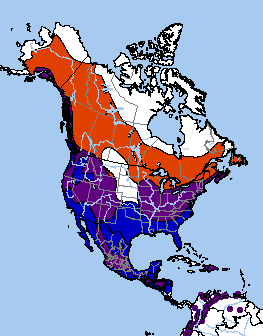
(Note that this map includes White-breasted and Plain-breasted Hawks.)
“Northern Sharp-shinned Hawk.” Breeds throughout the boreal forest region from western Alaska east throughout most of mainland Canada to Newfoundland and south mainly in coastal and mountain coniferous and mixed forests to northern Baja California, Oaxaca, the Ozarks, and the southern Appalachians.
Winters in wooded and semiopen habitats from south-coastal Alaska across southern Canada southward throughout the continental U.S., Mexico, and Central America to northern Colombia, Cuba, and the northern Bahamas. Casual elsewhere in the West Indies: e.g., Jamaica and Hispaniola.
“Cuban Sharp-shinned Hawk”. Rare and little-known, thought to be critically endangered and declining, possibly confined to mountain forests of southeastern Cuba.
“Hispaniolan Sharp-shinned Hawk”. Uncommon, local, and declining resident, mainly in mountains and foothills of central and southwestern Hispaniola.
“Puerto Rican Sharp-shinned Hawk”. Critically endangered and declining, on the brink of extinction, confined to wet mountain forests of southwestern Puerto Rico.
Identification
A small, slender, fast, bird-hunting raptor with a long, banded, square-tipped tail. The tail bands vary in thickness and number: usually shows three dark bars on the upperside and three or four on the underside.
“Northern Sharp-shinned Hawk” is easily confused with Cooper’s Hawk, which is larger but similar in all plumages, and extremely similar in some cases. Adults of both species are typically dark gray above with orange-and-white barring on the underparts. However, Sharp-shinned shows much more variability in its plumages.
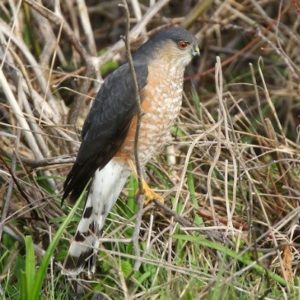
“Northern Sharp-shinned Hawk,” A. s. velox. (Freshwater Lagoon, Humboldt County, California; February 20, 2016.) © Glenn Anderson
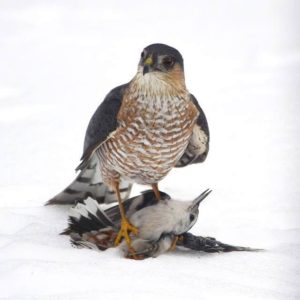
“Northern Sharp-shinned Hawk,” A. s. velox, with White-breasted Nuthatch. (New Hampton, New Hampshire; January 25, 2017.) © S. Andujar
For details on the “Cuban”, “Hispaniolan”, and “Puerto Rican” forms, click the respective links. Except where otherwise indicated, this page discusses only the “Northern” form.
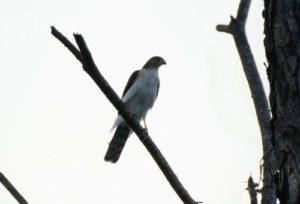
“Cuban Sharp-shinned Hawk,” A. s. fringilloides, Alejandro de Humboldt National Park, Cuba; November 19, 2017.) © Jean-Sébastien Guénette
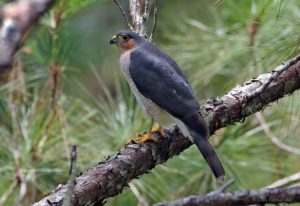
“Hispaniolan Sharp-shinned Hawk,” A. s. striatus. (Paso Bajito, Dominican Republic; June 13, 2015.) © Dax M. Román E.
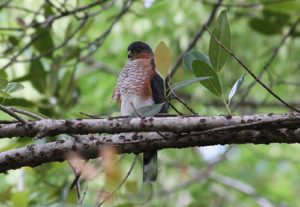
“Puerto Rican Sharp-shinned Hawk,” A. s. venator. (Maricao State Forest, Puerto Rico; March 31, 2012, ) © Nancy Crosby
Adult Plumages. The upperparts of adult “Northern Sharp-shinned Hawks” vary from bluish gray to blackish or brownish—and briefly have large white spots on their wings while molting. (Some of this variability is reflected in the photos below.)
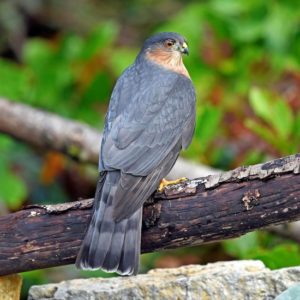
“Northern Sharp-shinned Hawk,” A. s. velox, with slaty or bluish-gray upperparts. (Harstine Island, Washington; October 1, 2017.) © Vickie Anderson
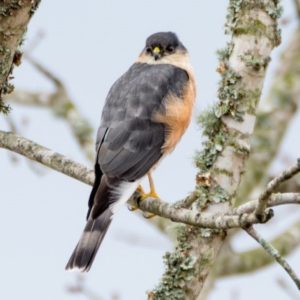
“Northern Sharp-shinned Hawk,” A. s. velox—note dark gray upperparts and salmon-colored breast feathers. (Lynchburg, Tennessee; February 12, 2017.) © Martin Hall
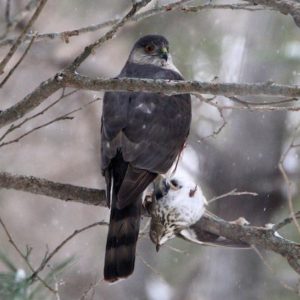
“Northern Sharp-shinned Hawk,” A. s. velox—note blackish upperparts and white cheeks and throat—with Hermit Thrush. (Polk County, Iowa; April 15, 2018.) © R.J. Thompson
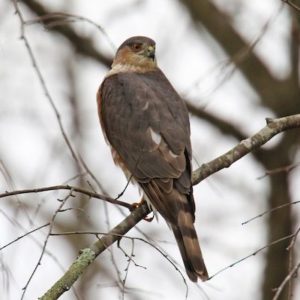
“Northern Sharp-shinned Hawk,” A. s. velox, adult with brown upperparts. (Minor E. Clark Fish Hatchery, Rowan County, Kentucky; March 30, 2017.) © David Lang
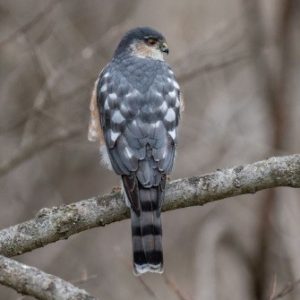
“Northern Sharp-shinned Hawk,” A. s. velox, showing whitish patches during molt. (Cedar Hill, Indiana; January 24, 2017.) © David Lang
The adult’s underparts vary from mostly white with pale orange barring to mostly dark orange or rufous with isolated white spots. The cheeks are typically orange or rufous, matching the underparts, but are sometimes white. In adults, the eyes are usually red, but can also be orange.
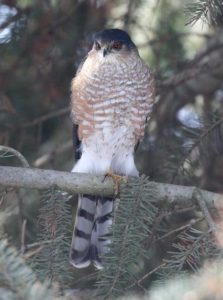
“Northern Sharp-shinned Hawk,” A. s. velox, with typical underparts coloration and pattern. (Vernon, British Columbia; February 27, 2017.) © Christopher Siddle
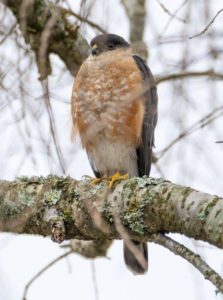
“Northern Sharp-shinned Hawk,” A. s. velox—this is the same individual that appears salmon-colored in a prior photo. (Lynchburg, Tennessee; February 12, 2017.) © Martin Hall
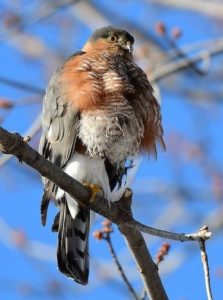
“Northern Sharp-shinned Hawk,” A. s. velox, with unusually vivid orange on cheeks and breast. (Québec City, Québec; December 16, 2017.) © Steeve R. Baker
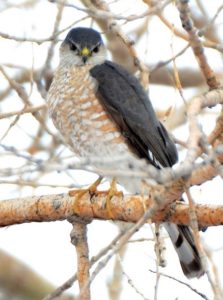
“Northern Sharp-shinned Hawk,” A. s. velox, with white faces and unusually pale underparts. (Flagler Reservoir State Wildlife Area, Colorado; April 24, 2013.) © Steven Mlodinow
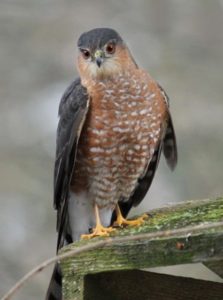
“Northern Sharp-shinned Hawk,” A. s. perobscurus—likely based on dark orange underparts and location. (Terrace, British Columbia; February 22, 2012.) © Diane Weismiller
Immature Plumages. Immatures have brown upperparts, with fine whitish streaks on the head and a pale brow, and paler underparts, with brown streaks throughout the breast. As they molt into adult plumage, they may show a mixture of streaks, chevrons, and bars, some brown and some more rusty or orange. Like adults, immatures briefly show large white spots on the back.
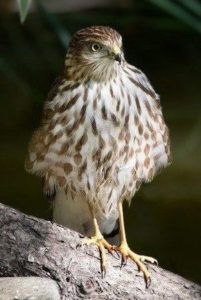
“Northern Sharp-shinned Hawk,” A. s. velox, typical juvenile plumage—note pale yellow eye. (Saskatoon, Saskatchewan; September 20, 2017.) © Nick Saunders
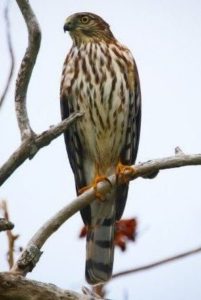
“Northern Sharp-shinned Hawk,” A. s. velox, juvenile. (Garden Key, Dry Tortugas National Park, Florida; October 22, 2017.) © Jeff Kietzmann
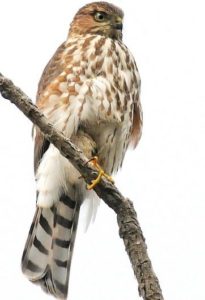
“Northern Sharp-shinned Hawk,” A. s. velox, immature developing adult pattern and color on underparts. (Prewitt Reservoir, Washington County, Colorado; September 17, 2011.) © Steven Mlodinow
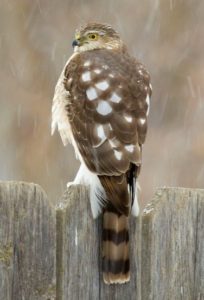
“Northern Sharp-shinned Hawk,” A. s. velox, immature showing whitish patches during molt. (Heron Haven, Douglas County, Nebraska; January 22, 2011.) © Brian Peterson
Below are examples of variability in the plumages of immature “Northern Sharp-shinned Hawk.” The upperparts are usually medium-brown, but can be paler, darker, or grayer. The underparts can be lightly or heavily streaked, or mostly brown with white spots. The eyes begin as yellow in juveniles and darken to orange, then red.
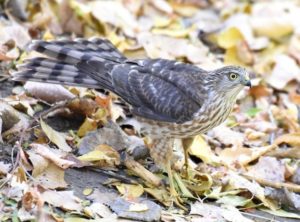
“Northern Sharp-shinned Hawk,” A. s. velox, immature showing grayish-brown upperparts. (Glenmere Park, Weld County, Colorado; October 17, 2017.) © Steven Mlodinow
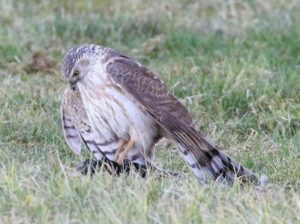
“Northern Sharp-shinned Hawk,” A. s. velox, immature with unusually pale, faintly streaked underparts. (Cape Sable Island, Nova Scotia; April 30, 2017.) © Mark Dennis

“Northern Sharp-shinned Hawk,” immature—likely A. s. perobscurus, based on dark overall plumage and location. (Morro Bay, California; February 25, 2018.) © Ann Vaughan
In Flight. “Northern Sharp-shinned Hawk” typically holds its wings slightly forward at the shoulder and and bent back at the wrist.
In all plumages, the wings appear boldly banded when viewed from below.
The tail is square-tipped or notched when folded, which helps differentiate it from Cooper’s Hawk.
When spread, however, the tail appears rounded, potentially causing confusion with Cooper’s Hawk.
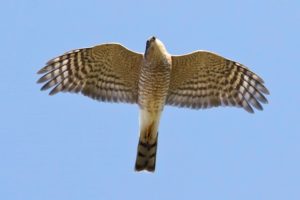
“Northern Sharp-shinned Hawk,” A. s. velox—note squarish, notched tail and profile of wings bent forward. (Ashland Nature Center and Hawk Watch, New Castle, Delaware; October 18, 2017.) © David Brown
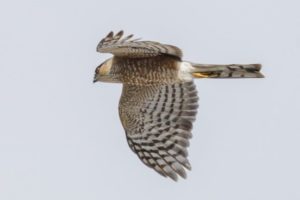
“Northern Sharp-shinned Hawk,” A. s. velox—note squarish, notched tail and profile of wings bent forward. (Saylorville Reservoir, Iowa; January 29, 2017.) © Kenny Younger
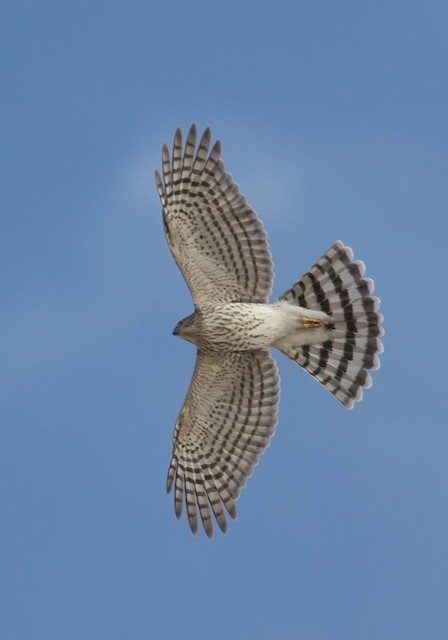
“Northern Sharp-shinned Hawk,” A. s. velox, juvenile with wings and tail fully spread—note projection of outer six primaries. (Texhoma, Oklahoma; November 11, 2017.) © Tony Leukering
Cf. Cooper’s Hawk. Distinguishing Sharp-shinned from Cooper’s Hawk is one of the classic identification puzzles for birdwatchers in North America. Adults show some consistent differences, but juveniles of the two species may appear essentially identical.
Cooper’s is larger in all dimensions—including having proportionately larger head, bill, wings, tail, and body girth—but female Sharp-shinned approaches the size of male Cooper’s, and many situational factors can distort the perception of an individual bird’s size, as well as the size of specific features.
Depending on the observation conditions, potentially useful distinctions include:
Crown Color: Adult Cooper’s has a blackish crown that usually contrasts with its paler nape, whereas Sharp-shinned’s crown and nape typically do not contrast with one another. On a perched Cooper’s, the blackish crown is often immediately apparent, making identification easy in such cases.
Tail Shape and Length: Sharp-shinned’s tail is essentially square-tipped, whereas on Cooper’s the central rectrices are longer than the outer retrices, so the tip appears rounded. The difference is often most noticeable on a bird in flight, seen from below—but when the tail is spread, this distinction disappears, as both appear rounded. Feather wear and molt stage can affect tail shape, so some Cooper’s may show square-tipped tails. Both species are long-tailed, but Cooper’s’ is longer. (Note that counting tail bands is rarely helpful due to individual variability within both species.)
Head Shape: Sharp-shinned’s head is proportionately small and rounded, whereas Cooper’s’ larger head has a more angular, squarish profile, often giving it a crested appearance.
Bill and Forehead: Cooper’s has a larger bill and cere, with a deeper base that merges with its forehead, whereas Sharp-shinned has a more vertical forehead and narrow-based bill, resulting in a more indented profile.
Wing Length and Shape: Cooper’s has proportionately longer wings and tends to extend them straight and perpendicular to its body, whereas Sharp-shinned tends to hold its shorter wings in a bowed posture, pressed forward from the shoulder and bent back at the wrist—but these are general tendencies, not absolute distinctions, and both species sometimes hold their wings in the fashion typical of the other.
Flight Pattern: Sharp-shinned tends to flap its wings vigorously in flight, whereas Cooper’s flies with fewer flaps and more gliding.
Body Mass: Generally, Cooper’s is robust and Sharp-shinned is svelte, an overall impression that is sometimes distinctive.
Plumage Coloration: Adult Cooper’s typically has medium-gray upperparts and evenly barred orange underparts. Many adult Sharp-shinned have essentially the same plumage as Cooper’s, but Sharp-shinned is far more variable, so atypically colored birds are almost always Sharp-shinned. The plumages of juveniles appear to have no consistent differences between the two species, and approximately the same range of variation, leaving size and shape as the principal distinctions.
Habitat: Sharp-shinned breeds mainly in coniferous northern and montane forests, whereas Cooper’s breeds in various forest types, mostly more southerly and at lower elevations than Sharp-shinned. Cooper’s has largely adapted to suburban habitats year-round, whereas Sharp-shinned occurs in such areas mainly on migration and in winter.
Notes
Polytypic species consisting of six recognized subspecies representing four distinct forms:
“Northern Sharp-shinned Hawk”, velox, of continental North America (includes perobscurus and suttoni)
“Cuban Sharp-shinned Hawk”, fringilloides, of Cuba
“Hispaniolan Sharp-shinned Hawk”, striatus, of Hispaniola
“Puerto Rican Sharp-shinned Hawk”, venator, of Puerto Rico
Often regarded as conspecific with White-breasted (chionogaster), Plain-breasted (ventralis), and Rufous-thighed (erythronemius) Hawks of the Neotropics, but the differences between them are pronounced. A fourth Neotropical form, the “Madrean Hawk” (madrensis), has traditionally been regarded as belonging to the Sharp-shinned group, but shows more commonalities with White-breasted, and is potentially a separate species in its own right.
References
Alderfer, J., and J.L. Dunn. 2014. National Geographic Complete Birds of North America. National Geographic Society, Washington, D.C.
eBird. 2018. eBird: An online database of bird distribution and abundance. Cornell Lab of Ornithology, Ithaca, N.Y. http://www.ebird.org. (Accessed September 24, 2018.)
Fagan, J., and O. Komar. 2016. Peterson Field Guide to the Birds of Northern Central America. Houghton Mifflin Harcourt. New York.
Ferguson-Lees, J., and D.A. Christie. 2001. Raptors of the World. Houghton-Mifflin, Boston.
Howell, S.N.G., and S.W. Webb. 1995. A Guide to the Birds of Mexico and Northern Central America. Oxford University Press, Oxford.
McMullan, M., and T. Donegan. 2014. Field Guide to the Birds of Colombia (Second Edition). Fundación Proaves de Colombia, Bogotá.
Raffaele, H., J. Wiley, O. Garrido, A. Keith, and J. Raffaele. 1998. A Guide to the Birds of the West Indies. Princeton University Press, Princeton, N.J.
Storer, R.W. 1952. Variation in the Resident Sharp-shinned Hawks of Mexico. Condor 54:283-289.
